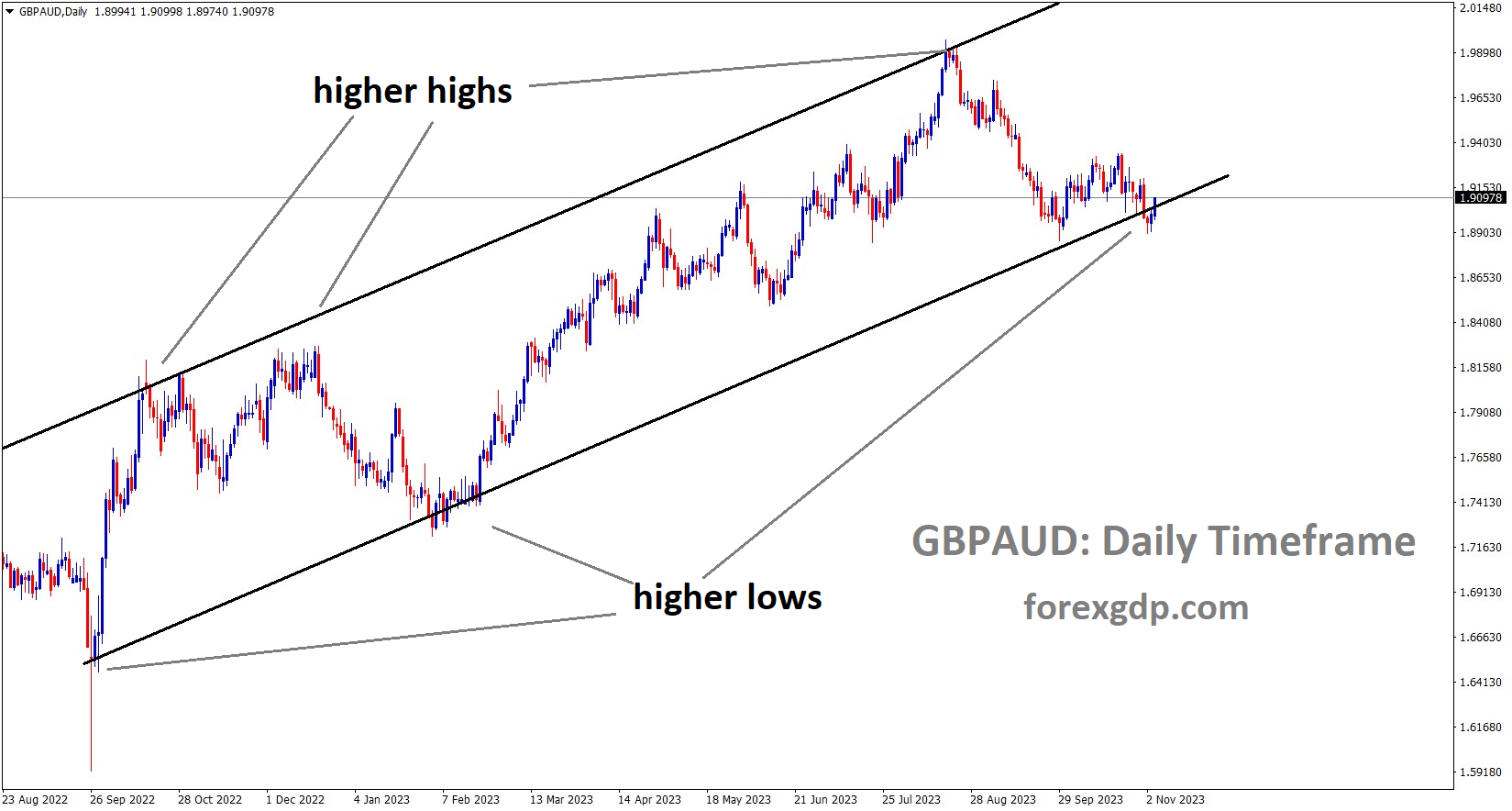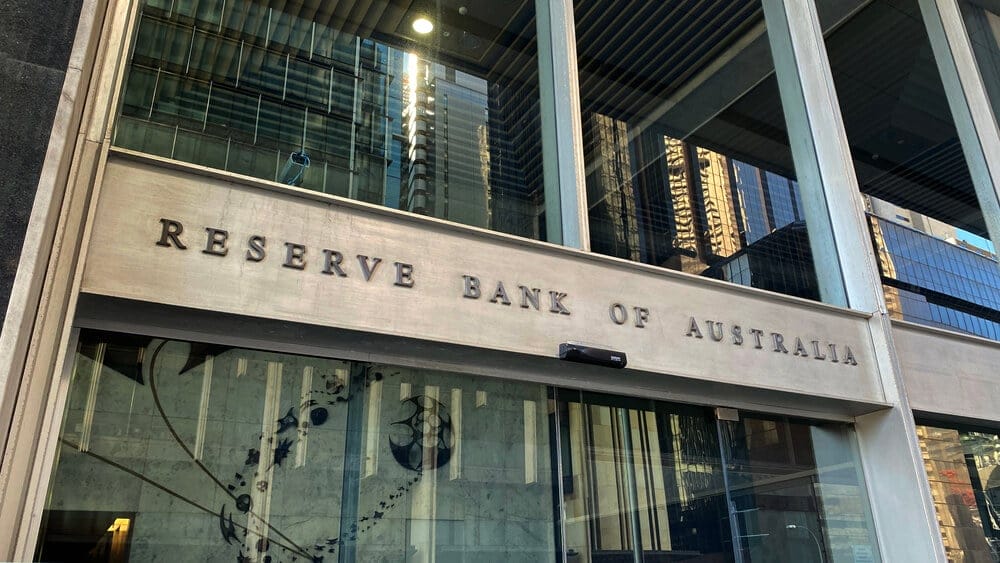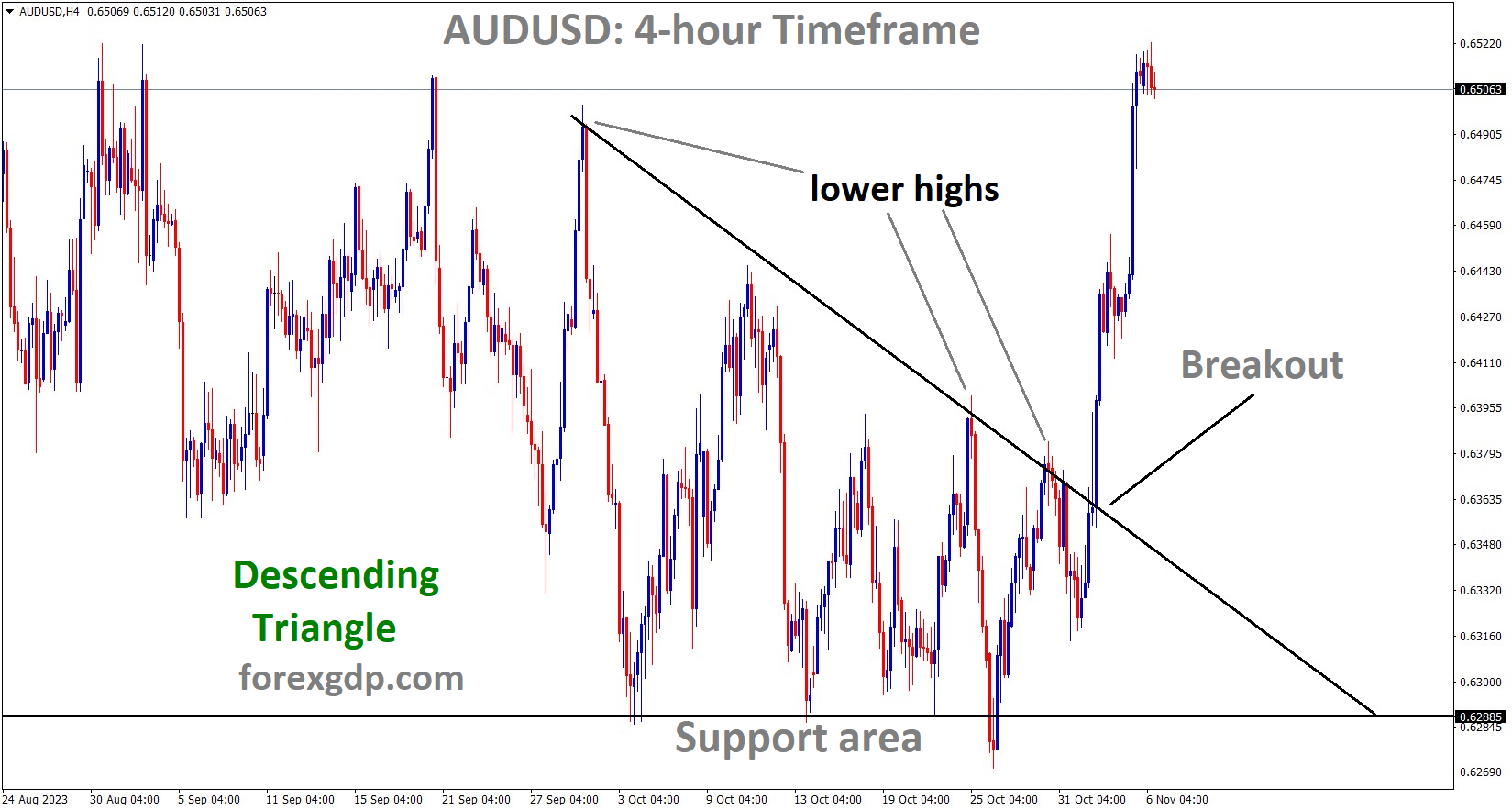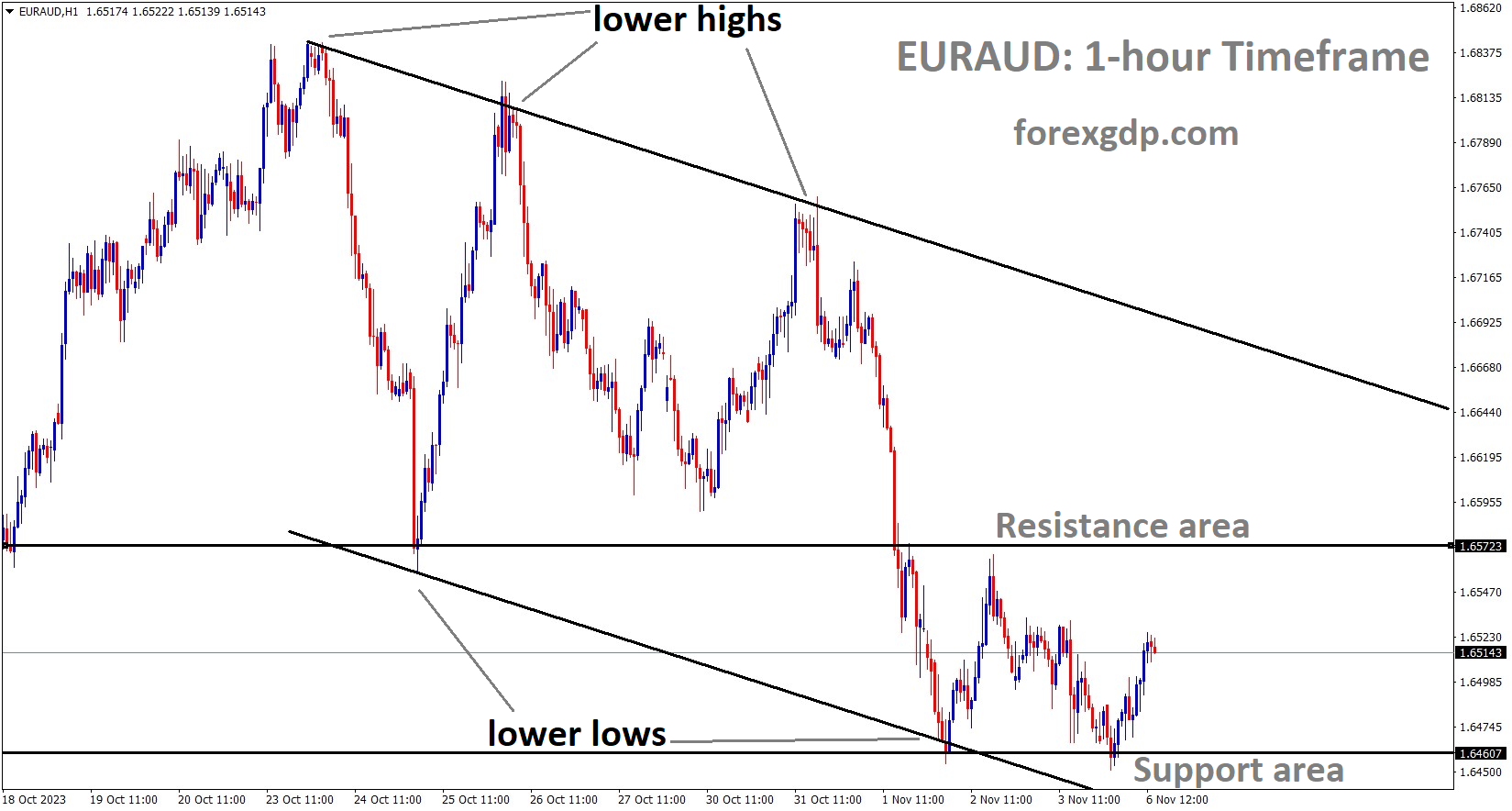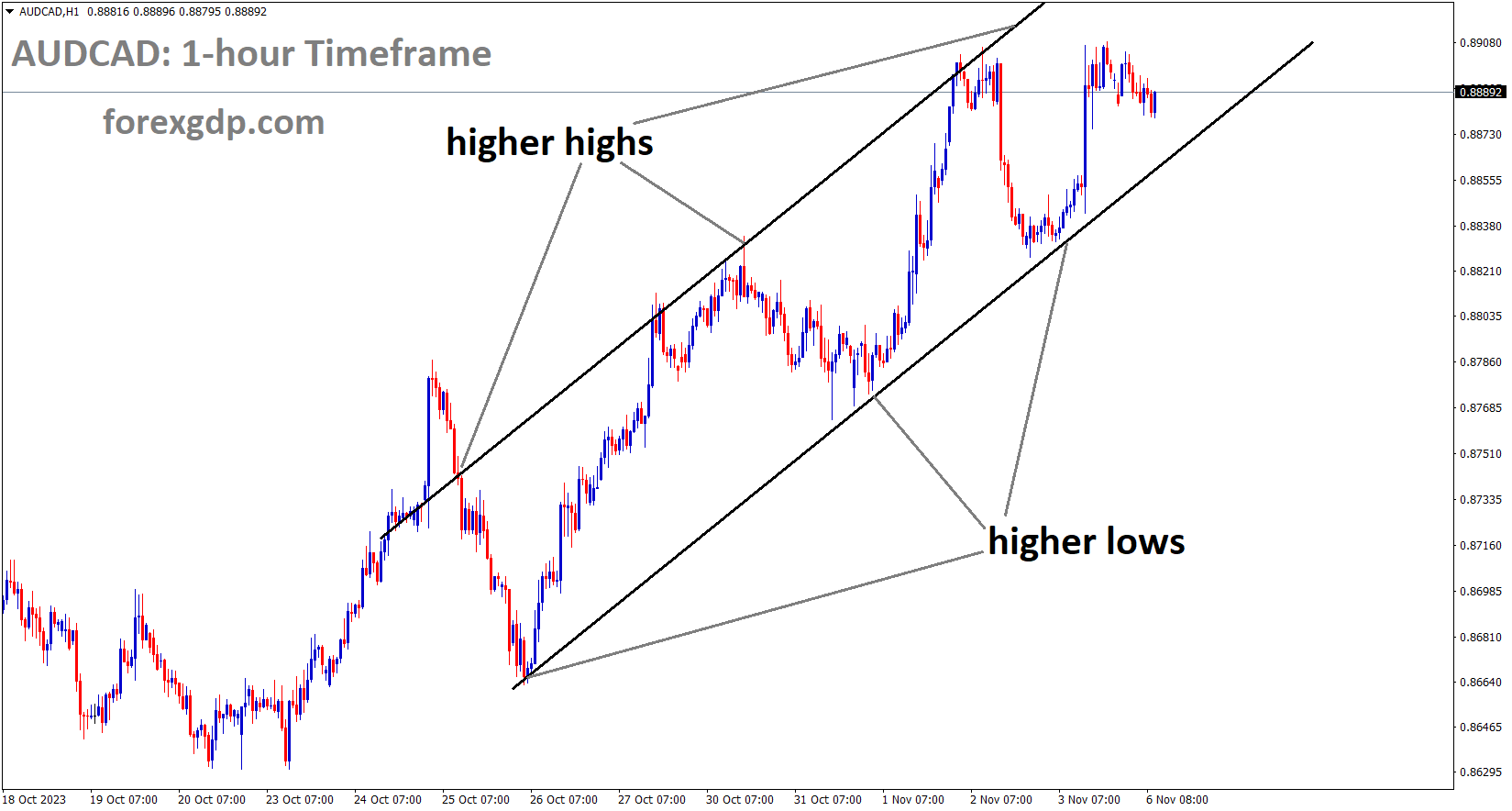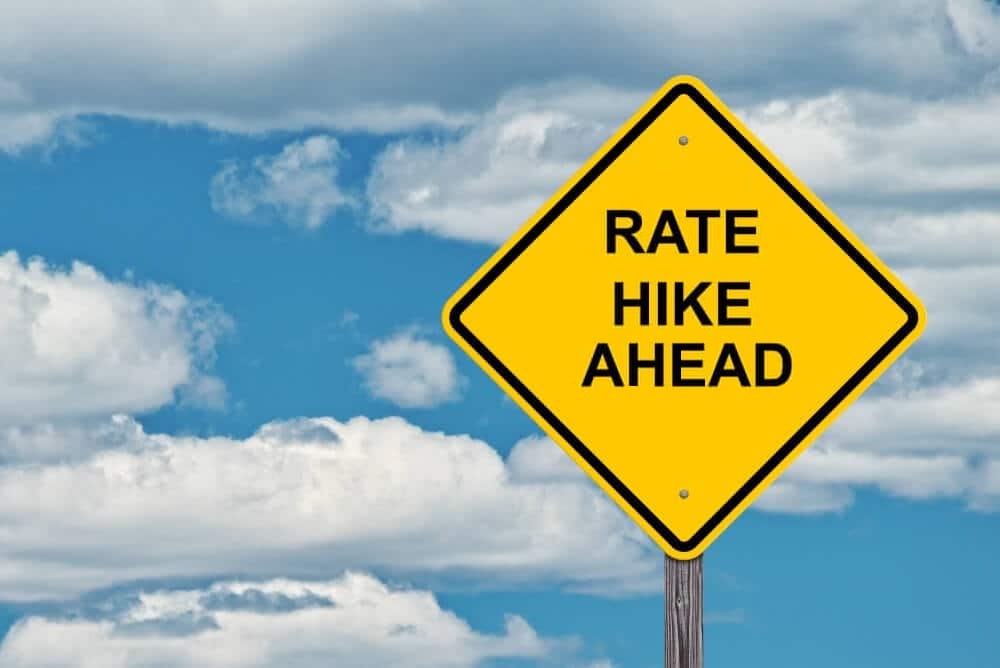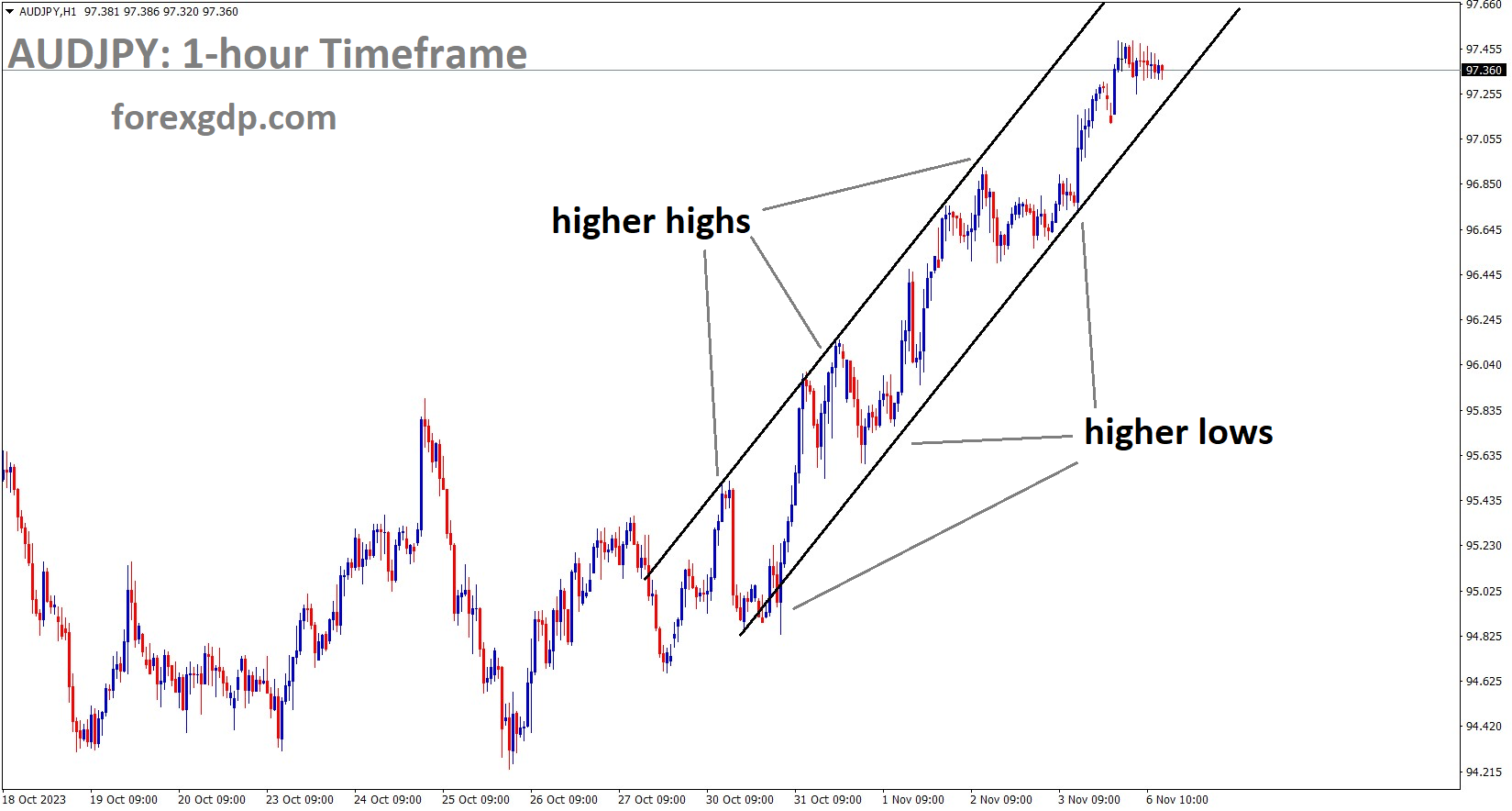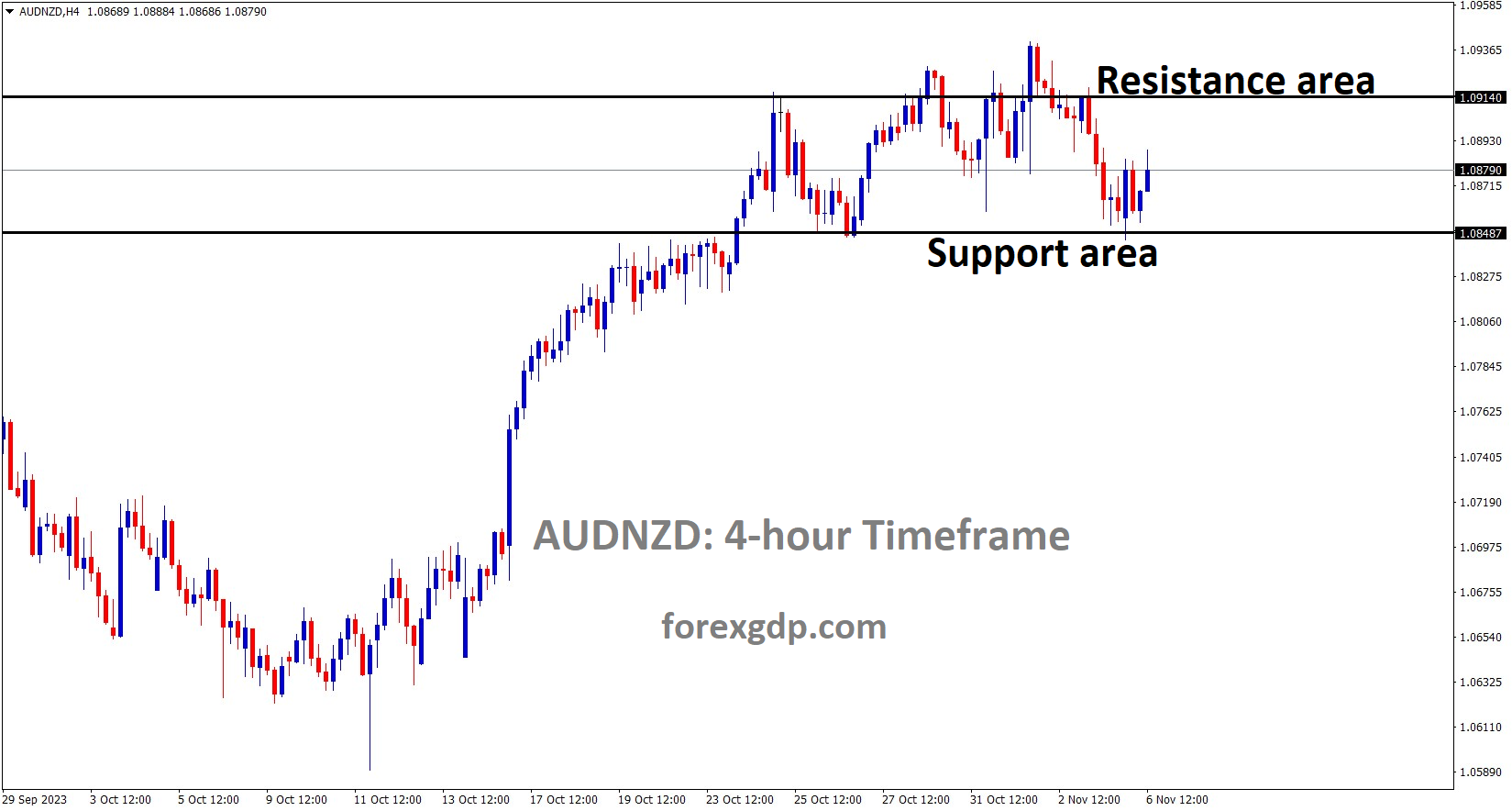GBPAUD is moving in an Ascending channel and the market has reached the higher low area of the channel
The RBA may consider a 25-basis-point rate hike in their upcoming meeting, driven by surging inflation and strong Q3 retail sales data.
Surprising Inflation Spurs Rate Hike
The Reserve Bank of Australia (RBA), Australia’s central bank, is poised to raise its key policy rate by 25 basis points to 4.35%, marking a significant shift in its monetary policy stance. This decision comes after the RBA had kept borrowing costs steady at its previous four meetings, reflecting concerns about the trajectory of inflation in the country. A recent Reuters poll has shed light on the prevailing sentiment among economists and financial experts regarding this anticipated rate hike.
In recent times, the inflation rate in Australia has exceeded expectations, catching policymakers off guard and leading to speculation about an impending rate hike. The financial markets have already factored in the probability of the RBA raising interest rates, marking a notable shift in sentiment compared to earlier expectations.
Unanimous Support for Rate Increase
The latest Reuters poll conducted from October 30 to November 2 reveals a remarkable consensus among economists, with near unanimity regarding an impending rate hike by the RBA. This unanimity is a significant departure from the earlier mixed opinions on the subject.
RBA’s First Hike Under Governor Michele Bullock
This rate hike, if realized, will be the first of its kind under the leadership of Governor Michele Bullock. Her tenure as the head of the RBA has been marked by a focus on managing inflation and ensuring the stability of the Australian economy. Governor Bullock has previously stated that the RBA would not hesitate to raise rates further if there is a substantial upward revision in the inflation outlook.
The appointment of Governor Bullock marked a shift in leadership at the RBA, and her approach to monetary policy has been closely watched by economists and financial markets. Her commitment to maintaining price stability and achieving the RBA’s inflation target has been a central theme of her tenure.
High Expectations for Rate Adjustment
The Reuters poll overwhelmingly supports the idea that the RBA will raise its official cash rate by 25 basis points to 4.35% on November 7. This level has not been seen since November 2011. Only a minority of economists hold differing opinions, predicting either a smaller hike or a different terminal rate. The near consensus among economists regarding this rate hike reflects the prevailing sentiment that the RBA is now prepared to take a more assertive stance to address inflationary pressures.
Factors Behind the Rate Hike Expectation
RBA’s Optimistic Inflation Forecasts Challenged
Economists attribute the expected rate hike to skepticism surrounding the RBA’s overly optimistic inflation forecasts for the second half of the year. The central bank’s forecasts had previously appeared too optimistic to many analysts, especially in light of the persistent inflationary pressures experienced in the Australian economy.
The RBA’s cautious approach to raising interest rates had been influenced by its belief that it could afford to wait and see, given its optimistic inflation projections. However, the unexpected surge in inflation has challenged these projections, leading to a reevaluation of the RBA’s stance.
Contrasting Global Monetary Policy
While the RBA prepares for a rate hike, most of its global counterparts, including the Reserve Bank of New Zealand, are in a wait-and-watch mode. This divergence in policy reflects the unique economic circumstances faced by Australia and its central bank.
AUDUSD has broken the Descending triangle pattern in upside
Australia’s economy has been marked by strong demand, particularly in the housing market, and rising inflation. In contrast, many other central banks around the world have been more cautious in their approach, given uncertainties related to the COVID-19 pandemic and its economic aftermath.
Impact on Australian Households
Property Market Resilience
Despite the RBA’s policy tightening, which has included a cumulative increase of 400 basis points, Australian house prices have rebounded to near previous peaks. This phenomenon has raised questions about the effectiveness of the central bank’s measures in cooling the property market.
The resilience of the property market has been a noteworthy development. It suggests that the RBA’s monetary policy actions may have had limited impact on cooling the red-hot property market, which has remained robust despite multiple rate hikes.
Potential Economic Consequences
An impending rate hike is expected to add to the cost of living for Australian households, particularly impacting those already grappling with a significant increase in mortgage costs. The potential economic consequences of this decision are a subject of concern.
Households that are heavily leveraged with mortgages are particularly vulnerable to rising interest rates. A rate hike could increase the cost of servicing these loans, potentially leading to financial stress for some borrowers. Additionally, the higher cost of borrowing could reduce consumer spending, affecting economic growth.
Market Reactions and Speculation
Shift in Market Sentiment
Market sentiment regarding the likelihood of a rate hike has shifted dramatically in response to recent inflation figures. Speculators in futures and bond markets are positioning for the possibility of higher interest rates. This shift in sentiment has been driven by the surprise increase in inflation, which has led to increased expectations of a more hawkish stance by the RBA.
Traders and investors closely monitor economic data releases and central bank statements for clues about future monetary policy actions. The unexpected rise in inflation figures has prompted many to adjust their portfolios in anticipation of a changing interest rate environment.
The Role of Inflation Figures
The prevailing belief among market participants is that the higher-than-expected inflation figures from the last quarter have increased the probability of the RBA raising interest rates. The uncertainty surrounding the central bank’s decision has led traders to follow the prevailing market sentiment.
EURAUD is moving in the Descending channel and the market has rebounded from the lower low area of the channel
Inflation is a key economic indicator that central banks use to determine their monetary policy actions. The unexpected uptick in inflation figures has raised concerns about the RBA’s ability to achieve its inflation target, potentially necessitating a more aggressive response.
Economic Implications of Inflation Data
Divergent Inflation Trends
While the quarterly Consumer Price Index (CPI) has moderated from 6.0% in June to 5.4% in September, the monthly CPI experienced an unexpected uptick from 5.2% annually in August to 5.6% in September. These contrasting trends in inflation data have added complexity to the RBA’s policy decisions.
The divergence between quarterly and monthly inflation figures highlights the volatility and unpredictability of inflation. The RBA must carefully assess the underlying factors contributing to these trends to make informed decisions about its monetary policy.
Persistent Inflationary Pressures
The underlying factors driving inflation in Australia, including fuel, food, and housing costs, have proven to be persistent. The RBA has repeatedly emphasized its commitment to tackling inflation, potentially necessitating further rate hikes.
Persistent inflationary pressures can erode the purchasing power of consumers and reduce the effectiveness of monetary policy. The RBA’s challenge lies in managing these pressures while maintaining economic stability.
RBA’s Strategy and Timing
The Rationale for a November Rate Hike
The decision to raise interest rates in November is seen as a strategic move by the RBA. It would provide a strong signal to the Australian population to exercise caution in their spending, stabilize the Australian dollar, and allow time for the economic impact of previous rate hikes to materialize.
November is viewed as a suitable timing for the rate hike, as it allows a bit more time for the impacts of the string of rate rises over the last year to flow through the economy. If the RBA were to hike rates in December, it might disrupt holiday spending and have a more significant impact on the economy.
Balancing Timing and Impact
Economists suggest that a November rate hike would provide the RBA with the opportunity to communicate its intentions and allow businesses and households to adjust their plans accordingly. This measured approach aims to prevent any abrupt disruptions to the economy while managing inflationary pressures.
AUDCAD is moving in an Ascending channel and the market has reached the higher low area of the channel
The RBA’s communication and timing are critical factors in ensuring a smooth transition to a higher interest rate environment. By taking proactive steps, the central bank can guide the Australian economy toward a more balanced state.
Rate Hike Consensus and Bank Reactions
Big Four Banks’ Projections
All major Australian banks, including ANZ, CBA, NAB, and Westpac, are in agreement that the RBA will raise interest rates by 25 basis points in the near future. Their projections align with the consensus among economists and financial experts.
Predictions for 2023 and Beyond
A substantial majority of economists, 28 out of 39, forecast that interest rates will reach 4.35% by the end of 2023. Among the remaining 11, six anticipate rates reaching 4.60%, one expects them to reach 4.25%, and four anticipate no change from the current rate of 4.10%.
Median Forecasts
The median forecasts among experts indicate that interest rates are expected to remain at 4.35% at least until the end of June 2024. This projection represents a quarter-longer timeline compared to the predictions from the previous month.
IMF’s Assessment and Recommendations
IMF’s Concerns Regarding Inflation
The International Monetary Fund (IMF) has expressed concerns about the persistently high inflation in Australia.
Despite the RBA’s previous rate hikes, inflation remains above the central bank’s target range. The IMF’s latest assessment of the Australian economy highlights the challenges in achieving price stability.
Tightening Monetary Policy Further
To address the inflation issue, the IMF recommends further tightening of monetary policy through higher interest rates.
AUDJPY is moving in an Ascending channel and the market has reached the higher high area of the channel
The IMF’s assessment suggests that Australia’s inflation rate will not return to the RBA’s target range of 2%-3% until early 2026 without additional rate hikes.
The Size of Rate Hikes
The IMF’s mission chief, Abdoul Wane, has not specified the exact magnitude of interest rate increases required to achieve the desired outcome. The size of the hikes will depend on various factors, including the psychological effects of rate hikes on market participants.
Market Consensus and RBA’s Stance
The majority of economists and financial markets anticipate a 0.25% rate hike at the RBA’s next board meeting, bringing the cash rate to 4.35%. This increase would mark the end of a four-month pause since the last rate hike and signify the 12th rate hike since May 2022.
RBA’s Decision-Making Process
Basis for the Rate Hike
The RBA’s decision to raise interest rates is based on a reassessment of the inflation outlook. The unexpected surge in inflation figures has compelled the central bank to take action to ensure that inflation remains within its target range.
Role of Inflation Forecasts
The RBA’s previous forecasts for inflation, which were optimistic, have come under scrutiny due to the persistence of inflationary pressures. The central bank’s inflation projections have been a key factor in its approach to monetary policy, and the divergence from these forecasts has prompted a policy adjustment.
Quarterly Statement on Monetary Policy
The RBA’s full quarterly statement on monetary policy, due on November 10, is expected to provide further insights into the central bank’s rationale for the rate hike. The statement will offer a comprehensive assessment of the economic conditions and outlook, providing context for the decision.
Economic Resilience and Fiscal Management
Australia’s Economic Resilience
Despite the challenges posed by inflation and the prospect of higher interest rates, Australia’s economy has demonstrated resilience. This resilience is evident in the country’s GDP growth, which is expected to remain positive, albeit at a slower pace.
Fiscal Deficit Management
Australia’s fiscal deficit has contracted at a faster rate compared to other advanced economies. The Australian government has managed to retain a significant portion of revenue gains resulting from higher commodity prices, rather than increasing spending significantly.
Potential for Infrastructure Coordination
There is room for improvement in coordinating infrastructure projects to alleviate price pressures and stimulate economic growth. This potential coordination could contribute to easing the strain on the economy.
Upside Risks and Opportunities
Factors Contributing to Upside Risks
Several factors contribute to upside risks in the Australian economy.
AUDNZD is moving in the Box pattern and the market has rebounded from the support area of the pattern
These include higher levels of migration, the expedited execution of public investment projects, and the possibility of accelerated housing price increases.
Housing Supply Challenges
Addressing housing supply challenges is crucial to managing housing affordability and supporting economic growth. The availability of housing can significantly impact consumer sentiment and household consumption through wealth effects.
Renewable Energy and Climate Measures
Australia’s transition to renewable energy and the implementation of climate-related policies are expected to play a role in shaping the country’s economic future. These measures can have far-reaching effects on various sectors and industries.
Taxation and Fiscal Policy
Fiscal Strategies for the Future
The IMF recommends fiscal strategies that focus on cutting deficits and promoting economic efficiency over the medium term. The use of underutilized indirect taxes is one option to achieve these goals.
Property Taxation vs. Stamp Duty
The IMF supports property taxes over stamp duty at the state level, with the aim of promoting housing affordability and improving the tax base. This shift in taxation policy can have significant implications for both property buyers and state governments.
Addressing Global Heating
The IMF advocates for an economy-wide carbon price or, alternatively, strong sector-specific policies that signal a price on carbon. These measures are seen as essential in addressing global heating and its associated challenges.
Safeguard Mechanism for Industry Emissions
The Australian government’s safeguard mechanism to tackle industrial emissions is considered an important milestone. The IMF suggests that expanding the coverage of this mechanism to a larger share of the economy could enhance its effectiveness in reducing emissions.
Renewable Energy Targets
Australia’s objective of increasing the share of renewable energy in the power grid to 82% by 2030 aligns with global efforts to combat climate change. This transition to cleaner energy sources can have significant implications for the energy sector and the broader economy.
Evolving Financial Landscape
Rate Hikes and Borrower Considerations
The recent rate hikes and the impending rate hike by the RBA have prompted borrowers to carefully consider their financial situations. Fixed-rate loans have witnessed rate increases, leading borrowers to evaluate their options.
Mortgage Stress Realities
A substantial portion of homeowners faces mortgage stress, with a significant percentage of their income dedicated to servicing their home loans. The shift from historically low interest rates to higher rates has exacerbated financial stress for some borrowers.
Balancing Economic Priorities
The RBA faces a challenging balancing act as it aims to control inflation while safeguarding economic stability. The decisions regarding interest rates and monetary policy will play a pivotal role in shaping Australia’s economic trajectory in the coming months and years.
In conclusion, the Reserve Bank of Australia’s decision to raise its key policy rate reflects the central bank’s efforts to address rising inflationary pressures and maintain economic stability. The consensus among economists and financial experts, along with the IMF’s recommendations, underscores the significance of this policy adjustment. The economic implications of this decision are far-reaching, affecting households, businesses, and the broader economy. The central bank’s strategic timing and communication will be crucial in guiding Australia through this transition to a higher interest rate environment.
Don’t trade all the time, trade forex only at the confirmed trade setups.
Get more confirmed trade setups here: forexgdp.com/buy/

